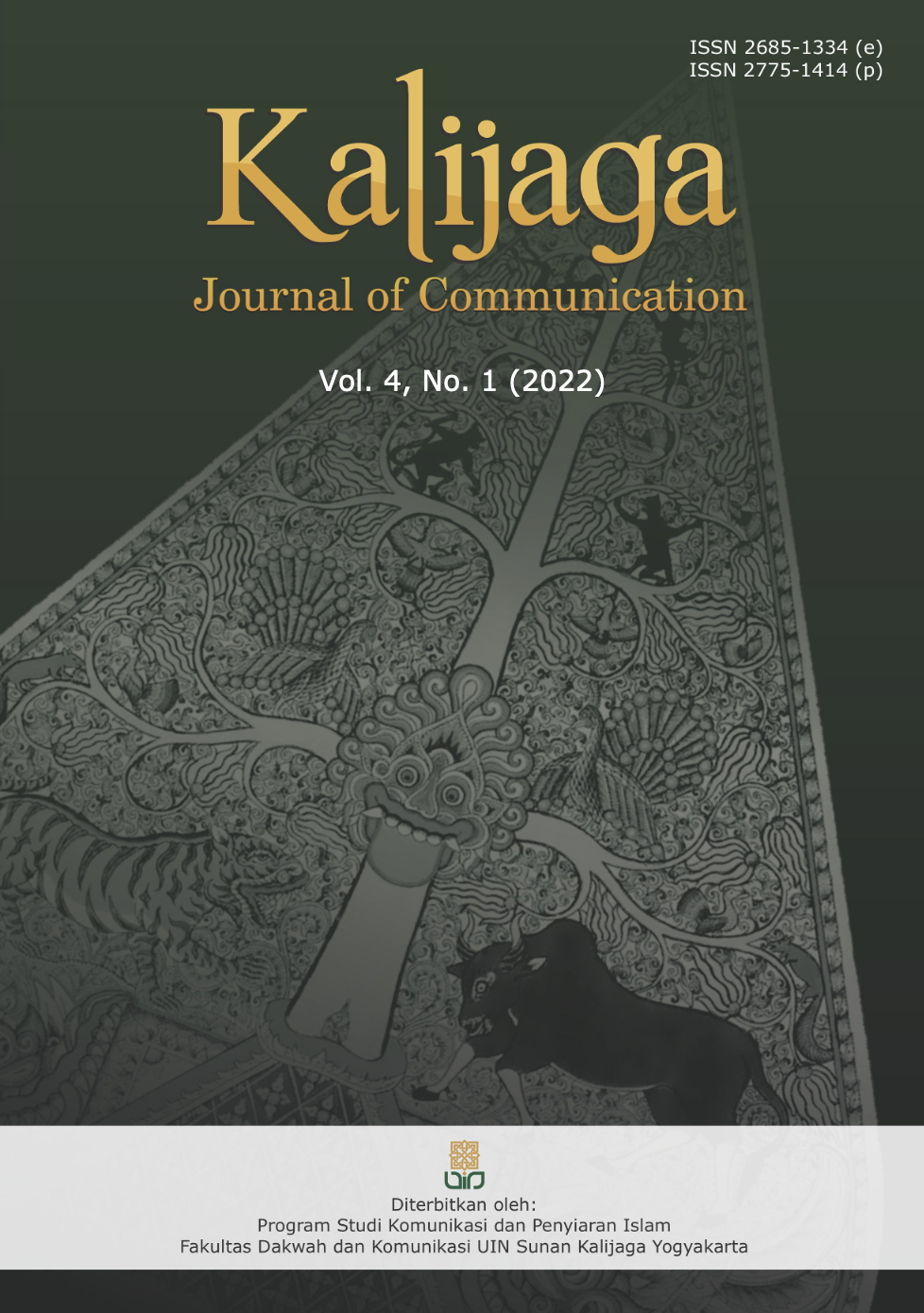Nada dan Dakwah: Analisis Diskursus atas Lirik Lagu “Perdamaian” dari Nasida Ria sebagai Komunikasi Dakwah Lewat Musik
DOI:
https://doi.org/10.14421/kjc.41.01.2022Keywords:
nasida ria, peace, discourse analysisAbstract
Nasida Ria is a qasidah music group from Semarang which was founded in 1975. This group is popular, one of which is through the song titled 'Peace' which was released in 1982. This article attempts to dismantle the link between the lyrics of the song and the global situation that surrounds it. When it emerged in 1982, global conditions were hot due to the cold war and the Iran-Iraq war. While popular again in 2022, 'Peace' is relevant to the conflict between Russia and Ukraine. The lyrics of 'Peace' were analyzed textually, microsociologically, and macrosociologically using a discourse analysis approach from Norman Fairclough. The analysis resulted in the conclusion that from a textual analysis, 'Peace' emphasizes the contradiction aspect in conveying its ideas. In addition, Peace also points to the subject of "you" as the excluded part and the subject of "me" as the included part. In a microsociological analysis, 'Peace' conveys an Islamic message that can be linked through intertextual analysis of the Qur'anic verse, namely Q.S. Al Anfal: 61, Q.S. Al Hujurat: 9, Q.S. An-Nisaa: 90. From a macro-sociological analysis, 'Peace' is relevant in the context of peace from wars involving weapons.
 Abstract viewed: 589 times
|
Abstract viewed: 589 times
|
 PDF downloaded = 1001 times
PDF downloaded = 1001 times
References
Abda, S. M. (1994). Prinsip-prinsip Metodologi Dakwah. Surabaya: Al Ikhlas.
Alek, A., Marzuki, A. G., Hidayat, D. N., & Sari, E. N. A. (2020). A Critical Dis- course Analysis of song “Look What You Made Me Do” by Taylor Swift. Eralingua: Jurnal Pendidikan Bahasa Asing Dan Sastra, 4(2), 154. https:// doi.org/10.26858/eralingua.v4i2.11199
Aripudin, A., Rizwan, M.R. (2009). Materi Dakwah pada Grup Musik Non-Religi. Jurnal Ilmu Dakwah Vol. 4 No. 13 Januari-Juni 2009.
Cholifah, U. (2013). Eksistensi Grup Musik Kasidah “Nasida Ria” Semarang dalam Menghadapi Modernisasi. KOMUNITAS: International Journal of Indonesian Society and Culture, 3(2). https://doi.org/10.15294/komunitas.v3i2.2309
Fadilah, Y., Aji, G.G. (2018). Kritik dan Realitas Sosial dalam Musik (Analisis Waca- na Kritis pada Lirik Lagu Karya Iksan Skuter “Lagu Petani”). Commercium. Volume 01 Nomor 02 Tahun 2019, 113-118
Falah, A.F. (2019). Grup Kasidah Modern Nasida Ria: Kreativitas Musik dan Fung- sionalisme Struktural. Tesis. Universitas Negeri Semarang.
Fairclough, N. (1995). Critical discourse analysis: the critical study of language. Longman.
Fairclough, N. (2003). Analysing Discourse: Textual Analysis for Social Research. Taylor & Francis Routledge.
Fairclough, N. (2010). Critical discourse analysis: the critical study of language (2nd ed.). Routledge.
Fauziyyah, A. S. F. (2020). Genre Baru Kasidah Sufistik di Indonesia 2001-2010. Historia Madania, 4(2), 373–388.
Fuchran, A. (1998). Pengantar Metode Penelitian Kualitatif. Surabaya: Penerbit Usaha Nasional.
Jorgensen, M., & Phillips, L. (2002). Discourse Analysis as Theory and Method. Los Angeles: Sage.
Lestarini, N. D. (2021). Analisis Wacana Kritis Teun A. Van Dijk atas Lirik Lagu ‘Ojo Mudik’ Ciptaan Didi Kempot. BATRA, Volume 7, Nomor 1.
Masnuna, dkk. (2021). Buku Biografi Visual Grup Kasidah Modern Nasida Ria. Jurnal Ilmu Komputer dan Desain Komunikasi Visual Volume 6, Nomor 1
Muhtadi, A. S. (2003). Komunikasi Dakwah: Teori, Pendekatan, dan Aplikasi (N. S. Nurbaya, Ed.). Bandung: PT. Remaja Rosdakarya.
Noer Faidah, S. Y., & Kusmawardi, S. (2016). Pembelajaran Rebana Qasidah di Baituttarbiyah (Rumah Pendidikan) Abu Zacky Al-zam Zamy Pangandaran. Swara: Jurnal Antologi Departemen Pendidikan Seni Musik FPSD UPI, 4(2).
Putri, I. T., & Triyono, S. (2018). “We Shall Overcome” A Humanity Song by Roger Waters: Critical Discourse Analysis. Jurnal Humaniora, 30(2), 119. https:// doi.org/10.22146/jh.32775
Qardhawi, Y. (2003). Halal Dan Haram Dalam Islam, Surabaya: Bina Ilmu. Romli, A. S. M. (2006). Kembalikan Nasyid pada Khittahnya (M. A. Hadhirin, Ed.). Bandung: Marja.
Zakriyanti, Sopar. (2022). The Values of Sufism in Qasidah of Nasida Ria. Fitrah Volume 4 Nomor 1.
Downloads
Published
Issue
Section
License
Copyright (c) 2022 Sekar Arum Mandalia

This work is licensed under a Creative Commons Attribution-ShareAlike 4.0 International License.
Authors who publish with this journal agree to the following terms:
- Authors retain copyright and grant the journal right of first publication with the work simultaneously licensed under a Creative Commons Attribution-NonCommercial-ShareAlike 4.0 International License. that allows others to share and adapt the work with an acknowledgement of the work's authorship and initial publication in this journal.
- Authors are able to enter into separate, additional contractual arrangements for the non-exclusive distribution of the journal's published version of the work (e.g., post it to an institutional repository or publish it in a book), with an acknowledgement of its initial publication in this journal.
- Authors are permitted and encouraged to post their work online (e.g., in institutional repositories or on their website) prior to and during the submission process, as it can lead to productive exchanges, as well as earlier and greater citation of published work (See The Effect of Open Access).






























